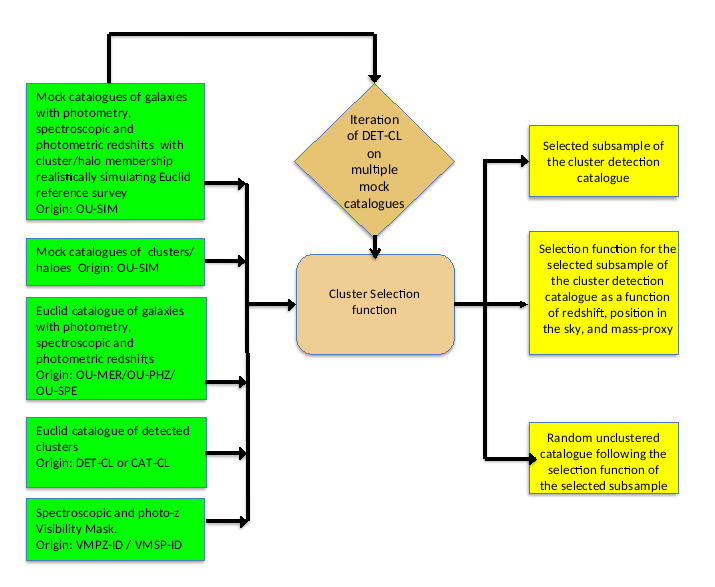
Introduction¶
The OU-LE3 SEL-CL PF shall provide subsamples of the cluster catalog, the selection function corresponding to the photometric cluster catalogue provided by each cluster detection algorithm, and a random unclustered catalogue that matches the angular and redshift selection of clusters.

- The input products are:
the inputs of DET-CL (or “Clusters Pipeline”): the Galaxies catalogue, the photometric redshift catalogue (not mentioned on the figure above) and the photometric mask
the outputs of CAT-CL: the catalogue of cluster candidates, and the galaxies membership catalogue.
the “truth tables”: the mock catalogue of galaxies (with their photometric and possibly spectroscopic redshifts, and halo/cluster membership), and the mock catalogue of haloes/clusters
- The output products are:
a subsample of the cluster detection catalogue, selected according to a range of parameters: central position in projected coordinates (right ascension and declination), signal-to-noise of the detection, richness or/and amplitude, detection redshift.
the random unclustered catalogue that matches the subsample selection of clusters and contains at least 50 times more objects than the cluster catalog.
the selection function for the subsample of the cluster detection catalogue (for all locations on the celestial sphere covered by the Euclid Survey), as a function of redshift, richness or signal to noise. The selection function currently includes six sets of tables:
Prob(lambda_true | lambda_obs, z_true | z_obs), organized as a “table of tables”. A first level samples the coverage of (lambda_obs, z_obs). For each cell in this plan, the second level gives Prob(lambda_true | lambda_obs, z_true | z_obs)
Completeness(&lambda_obs, z_obs)
Purity(lambda_true, z_true)
Three tables giving, each, the statistical errors associated with one of the three quantities described above (Prob, Completeness, Purity). Each of these table has the same format as its related quantity.
Possible intermediate products (TBC) are:
A matching file, where the entries are the reference sources (i.e. the “truth” table), and containing information on their possible match with a detected source.
A matching file, where the entries are the detected sources, and containing information on their possible match with a reference source (i.e. with the “truth” table)
Inputs products
Catalogue of Fully Characterized Clusters, from both detection methods (Output Product)
Catalogue of member galaxies, from both detection methods (Output Product)
Outputs products
